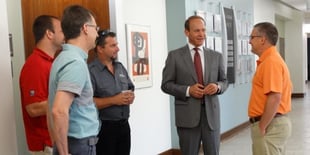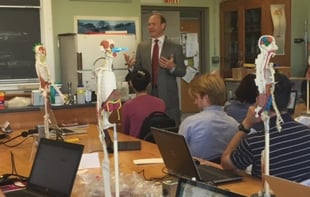Stephanie Cunningham is a few months into teaching PLTW Launch at Memorial School in Medway, Massachusetts, and her journey from Core Training to implementation is inspiring. Project Lead The Way President and CEO Vince Bertram recently had the opportunity to visit her classroom, where fourth graders were observing what happens when model cars collide in the middle of a U-shaped ramp.
Read on to learn more from our conversation with Stephanie.
Project Lead The Way: How long have you been teaching?
Stephanie Cunningham: I'm currently in my fifth year teaching, and this is my fourth year as a science teacher. I just started teaching PLTW in September.
PLTW: How was your experience with Core Training?
S.C.: My colleague Marissa Keleher and I had a great experience at Core Training in South Carolina. We were excited to learn more about PLTW, and after leaving the training, were eager to see the lessons and get started. We enjoyed the variety of experiences – how it would feel as a student, teacher, and then Lead Teacher. We also appreciated the time we had to learn how to navigate the LMS. We were initially surprised to have homework each night, but found it to be very manageable.
PLTW: What are some of the challenges a new Launch teacher faces?
S.C.: The initial transition to PLTW was fairly seamless for me, as our science program was already inquiry based as opposed to teaching from a textbook.
One of the biggest challenges I've faced personally, and continue to work through, is the time it takes to complete a unit. This brought up a greater issue to me: What is more important – to ensure that all the content of the lesson is covered, or to give the students the time to work through procedural road blocks and find solutions on their own?
At first, I thought the lessons were too advanced for the students without substantial scaffolding. As I've progressed through the unit, though, I've realized there is a great issue here: We are always so pressed for time in school that we never give students the opportunity to solve problems they encounter unless they are directly related to the curriculum – and even sometimes then we don't.
It would be easier to have the ramps already made for students with the numbers measured and marked on them so that students could go straight to collecting their data using the ramps. I've decided, however, to invest the time in having students make their own ramps, problem solve, and figure out how to use a ruler, even if this wasn't one of the initial intents of the lesson. As a result, not all groups had the time to collect all their data. Trying to find a happy balance is certainly something I am still working on.
PLTW: What are some of the successes you’ve seen in the classroom?
S.C.: The number one success I've seen is that ALL students appear to love the lessons. Although I of course want my students to leave my room with the scientific concepts I've taught, my number one goal is always that they leave with a love for science. PLTW is certainly helping make this a reality.
One of my favorite stories, though, is about a student who is normally very withdrawn from school and struggles to complete work. I will never forget the image of him completing the construction of his car as he began to cheer and dance with excitement. As the unit has progressed, I've also seen his work and class participation increase. He has gone from a child with his head on the table to one who now runs over to show me the collision they caught in the SloPro app.
PLTW: What advice would you give to other new Launch teachers or teachers considering pursuing it?
S.C.: To be on the safe side, I would double the time for the unit. If the lesson plans state that it will take 10 hours to complete, I would count on 15-20. I think if you go into teaching the unit committed to spending this amount of time on it, you won't feel as pressured to push the students to complete their work quickly. I think it is really important for them to have time to explore each step, make mistakes, and have time to fully process their thoughts.
PLTW: What are you looking forward to as you continue with PLTW Launch?
S.C.: I'm looking forward to the lessons to come as students put all of their learning into designing their vehicles. We've called them “our cars to save Humpty Dumpty," and we draw faces on our eggs. I'm sure there will be many more stories to come!
Stay current on Vince’s travels – and the latest in education and workforce development news – by following him on Twitter at @VinceBertram.


